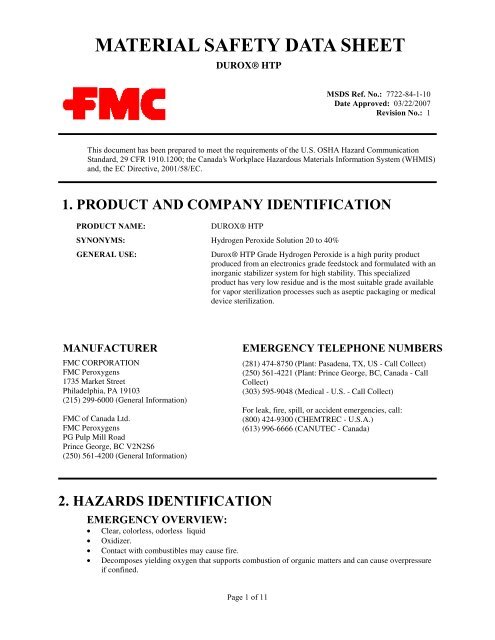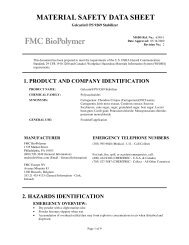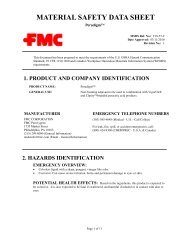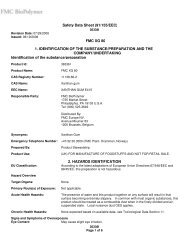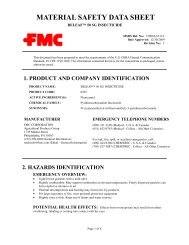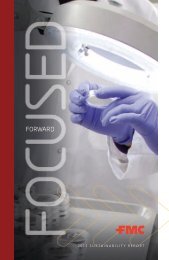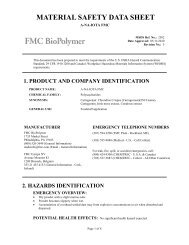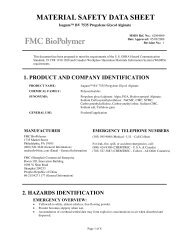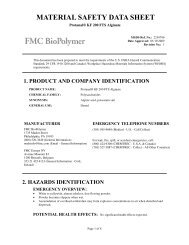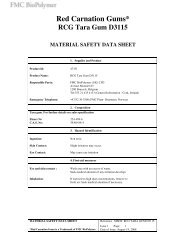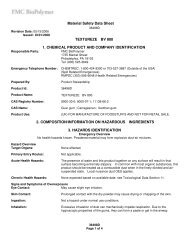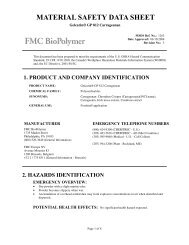material safety data sheet - FMC Corporation
material safety data sheet - FMC Corporation
material safety data sheet - FMC Corporation
Create successful ePaper yourself
Turn your PDF publications into a flip-book with our unique Google optimized e-Paper software.
MATERIAL SAFETY DATA SHEET<br />
DUROX® HTP<br />
Page 1 of 11<br />
MSDS Ref. No.: 7722-84-1-10<br />
Date Approved: 03/22/2007<br />
Revision No.: 1<br />
This document has been prepared to meet the requirements of the U.S. OSHA Hazard Communication<br />
Standard, 29 CFR 1910.1200; the Canada’s Workplace Hazardous Materials Information System (WHMIS)<br />
and, the EC Directive, 2001/58/EC.<br />
1. PRODUCT AND COMPANY IDENTIFICATION<br />
PRODUCT NAME: DUROX® HTP<br />
SYNONYMS: Hydrogen Peroxide Solution 20 to 40%<br />
GENERAL USE: Durox® HTP Grade Hydrogen Peroxide is a high purity product<br />
produced from an electronics grade feedstock and formulated with an<br />
inorganic stabilizer system for high stability. This specialized<br />
product has very low residue and is the most suitable grade available<br />
for vapor sterilization processes such as aseptic packaging or medical<br />
device sterilization.<br />
MANUFACTURER<br />
<strong>FMC</strong> CORPORATION<br />
<strong>FMC</strong> Peroxygens<br />
1735 Market Street<br />
Philadelphia, PA 19103<br />
(215) 299-6000 (General Information)<br />
<strong>FMC</strong> of Canada Ltd.<br />
<strong>FMC</strong> Peroxygens<br />
PG Pulp Mill Road<br />
Prince George, BC V2N2S6<br />
(250) 561-4200 (General Information)<br />
2. HAZARDS IDENTIFICATION<br />
EMERGENCY TELEPHONE NUMBERS<br />
(281) 474-8750 (Plant: Pasadena, TX, US - Call Collect)<br />
(250) 561-4221 (Plant: Prince George, BC, Canada - Call<br />
Collect)<br />
(303) 595-9048 (Medical - U.S. - Call Collect)<br />
For leak, fire, spill, or accident emergencies, call:<br />
(800) 424-9300 (CHEMTREC - U.S.A.)<br />
(613) 996-6666 (CANUTEC - Canada)<br />
EMERGENCY OVERVIEW:<br />
• Clear, colorless, odorless liquid<br />
• Oxidizer.<br />
• Contact with combustibles may cause fire.<br />
• Decomposes yielding oxygen that supports combustion of organic matters and can cause overpressure<br />
if confined.
DUROX® HTP (7722-84-1-10) Date: 03/22/2007<br />
• Corrosive to eyes, nose, throat, lungs and gastrointestinal tract.<br />
POTENTIAL HEALTH EFFECTS: Corrosive to eyes, nose, throat and lungs. May cause<br />
irreversible tissue damage to the eyes including blindness. May cause skin irritation.<br />
3. COMPOSITION / INFORMATION ON INGREDIENTS<br />
Chemical Name CAS# Wt.% EC No. EC Class<br />
Hydrogen Peroxide 7722-84-1 20 - 40 231-765-0 Xn, R22-37/38-41; S1/2-3-<br />
17-26-28-36/37/39-45<br />
Water 7732-18-5 60 - 80 231-791-2 Not classified<br />
4. FIRST AID MEASURES<br />
EYES: Immediately flush with water for at least 15 minutes, lifting the upper and lower eyelids<br />
intermittently. See a medical doctor or ophthalmologist immediately.<br />
SKIN: Wash with plenty of soap and water. Get medical attention if irritation occurs and persists.<br />
INGESTION: Rinse mouth with water. Dilute by giving 1 or 2 glasses of water. Do not induce<br />
vomiting. Never give anything by mouth to an unconscious person. See a medical doctor immediately.<br />
INHALATION: Remove to fresh air. If breathing difficulty or discomfort occurs and persists,<br />
contact a medical doctor.<br />
NOTES TO MEDICAL DOCTOR: Hydrogen peroxide at these concentrations is a strong<br />
oxidant. Direct contact with the eye is likely to cause corneal damage especially if not washed immediately.<br />
Careful ophthalmologic evaluation is recommended and the possibility of local corticosteroid therapy<br />
should be considered. Because of the likelihood of corrosive effects on the gastrointestinal tract after<br />
ingestion, and the unlikelihood of systemic effects, attempts at evacuating the stomach via emesis induction<br />
or gastric lavage should be avoided. There is a remote possibility, however, that a nasogastric or orogastric<br />
tube may be required for the reduction of severe distension due to gas formation.<br />
5. FIRE FIGHTING MEASURES<br />
EXTINGUISHING MEDIA: Flood with water.<br />
Page 2 of 11
DUROX® HTP (7722-84-1-10) Date: 03/22/2007<br />
FIRE / EXPLOSION HAZARDS: Product is non-combustible. On decomposition releases<br />
oxygen which may intensify fire.<br />
FIRE FIGHTING PROCEDURES: Any tank or container surrounded by fire should be<br />
flooded with water for cooling. Wear full protective clothing and self-contained breathing apparatus.<br />
FLAMMABLE LIMITS: Non-combustible<br />
SENSITIVITY TO IMPACT: No <strong>data</strong> available<br />
SENSITIVITY TO STATIC DISCHARGE: No <strong>data</strong> available<br />
6. ACCIDENTAL RELEASE MEASURES<br />
RELEASE NOTES: Dilute with a large volume of water and hold in a pond or diked area until<br />
hydrogen peroxide decomposes. Hydrogen peroxide may be decomposed by adding sodium metabisulfite<br />
or sodium sulfite after diluting to about 5%. Dispose according to methods outlined for waste disposal.<br />
Combustible <strong>material</strong>s exposed to hydrogen peroxide should be immediately submerged in or rinsed with<br />
large amounts of water to ensure that all hydrogen peroxide is removed. Residual hydrogen peroxide that is<br />
allowed to dry (upon evaporation hydrogen peroxide can concentrate) on organic <strong>material</strong>s such as paper,<br />
fabrics, cotton, leather, wood or other combustibles can cause the <strong>material</strong> to ignite and result in a fire.<br />
7. HANDLING AND STORAGE<br />
HANDLING: Wear chemical splash-type monogoggles and full-face shield, impervious clothing,<br />
such as rubber, PVC, etc., and rubber or neoprene gloves and shoes. Avoid cotton, wool and leather. Avoid<br />
excessive heat and contamination. Contamination may cause decomposition and generation of oxygen gas<br />
which could result in high pressures and possible container rupture. Hydrogen peroxide should be stored<br />
only in vented containers and transferred only in a prescribed manner (see <strong>FMC</strong> Technical Bulletins).<br />
Never return unused hydrogen peroxide to original container, empty drums should be triple rinsed with<br />
water before discarding. Utensils used for handling hydrogen peroxide should only be made of glass,<br />
stainless steel, aluminum or plastic.<br />
STORAGE: Store drums in cool areas out of direct sunlight and away from combustibles. For bulk<br />
storage refer to <strong>FMC</strong> Technical Bulletins.<br />
COMMENTS: VENTILATION: Provide mechanical general and/or local exhaust ventilation to<br />
prevent release of vapor or mist into the work environment.<br />
Page 3 of 11
DUROX® HTP (7722-84-1-10) Date: 03/22/2007<br />
8. EXPOSURE CONTROLS / PERSONAL PROTECTION<br />
EXPOSURE LIMITS<br />
Chemical Name ACGIH OSHA Supplier<br />
Hydrogen Peroxide<br />
1 ppm (TWA)<br />
Page 4 of 11<br />
1 ppm (PEL)<br />
ENGINEERING CONTROLS: Ventilation should be provided to minimize the release of<br />
hydrogen peroxide vapors and mists into the work environment. Spills should be minimized or confined<br />
immediately to prevent release into the work area. Remove contaminated clothing immediately and wash<br />
before reuse.<br />
PERSONAL PROTECTIVE EQUIPMENT<br />
EYES AND FACE: Use chemical splash-type monogoggles and a full-face shield made<br />
of polycarbonate, acetate, polycarbonate/acetate, PETG or thermoplastic.<br />
RESPIRATORY: If concentrations in excess of 10 ppm are expected, use NIOSH/DHHS<br />
approved self-contained breathing apparatus (SCBA), or other approved atmospheric-supplied<br />
respirator (ASR) equipment (e.g., a full-face airline respirator (ALR)). DO NOT use any form of<br />
air-purifying respirator (APR) or filtering facepiece (AKA dust mask), especially those containing<br />
oxidizable sorbants such as activated carbon.<br />
PROTECTIVE CLOTHING: For body protection wear impervious clothing such as<br />
an approved splash protective suit made of SBR Rubber, PVC (PVC Outershell w/Polyester<br />
Substrate), Gore-Tex (Polyester trilaminate w/Gore-Tex), or a specialized HAZMAT Splash or<br />
Protective Suite (Level A, B, or C). For foot protection, wear approved boots made of NBR, PVC,<br />
Polyurethane, or neoprene. Overboots made of Latex or PVC, as well as firefighter boots or<br />
specialized HAZMAT boots are also permitted. DO NOT wear any form of boot or overboots<br />
made of nylon or nylon blends. DO NOT use cotton, wool or leather, as these <strong>material</strong>s react<br />
RAPIDLY with higher concentrations of hydrogen peroxide. Completely submerge hydrogen<br />
peroxide contaminated clothing or other <strong>material</strong>s in water prior to drying. Residual hydrogen<br />
peroxide, if allowed to dry on <strong>material</strong>s such as paper, fabrics, cotton, leather, wood or other<br />
combustibles can cause the <strong>material</strong> to ignite and result in a fire.<br />
GLOVES: For hand protection, wear approved gloves made of nitrile, PVC, or neoprene.<br />
DO NOT use cotton, wool or leather for these <strong>material</strong>s react RAPIDLY with higher<br />
concentrations of hydrogen peroxide. Thoroughly rinse the outside of gloves with water prior to<br />
removal. Inspect regularly for leaks.<br />
9. PHYSICAL AND CHEMICAL PROPERTIES<br />
ODOR: Odorless<br />
APPEARANCE: Clear, colorless liquid<br />
AUTOIGNITION TEMPERATURE: Non-combustible
DUROX® HTP (7722-84-1-10) Date: 03/22/2007<br />
BOILING POINT: 103ºC/218ºF (20%); 107ºC/225ºF (31%); 108ºC/226ºF<br />
(35%); 105ºC/221ºF (25%)<br />
COEFFICIENT OF OIL / WATER: Not available<br />
DENSITY / WEIGHT PER VOLUME: Not available<br />
EVAPORATION RATE: >1 (Butyl Acetate = 1)<br />
FLASH POINT: Non-combustible<br />
FREEZING POINT: -15ºC/6ºF (20%); -26ºC/-15ºF (31%); -33ºC/-27ºF (35%);<br />
-19.5ºC/-3.1ºF (25%)<br />
ODOR THRESHOLD: Not available<br />
OXIDIZING PROPERTIES: Strong oxidizer<br />
PERCENT VOLATILE: 100%<br />
pH: (as is) 1 - 3<br />
SOLUBILITY IN WATER: (in H2O % by wt) 100%<br />
SPECIFIC GRAVITY: 1.07 @ 20ºC/4ºC (20%); 1.11 @ 20ºC/4ºC (31%); 1.13 @<br />
20ºC/4ºC (35%); 1.09 @ 25ºC/4ºC (25%)<br />
VAPOR DENSITY: (Air = 1): Not available<br />
VAPOR PRESSURE: 28 mmHg @ 30ºC (20%); 24 mmHg @ 30ºC (31%); 23<br />
mmHg @ 30ºC (35%); 26 mmHg @ 30ºC (25%)<br />
10. STABILITY AND REACTIVITY<br />
CONDITIONS TO AVOID: Excessive heat or contamination could cause<br />
product to become unstable.<br />
STABILITY: Stable (heat and contamination could cause<br />
decomposition)<br />
POLYMERIZATION: Will not occur<br />
INCOMPATIBLE MATERIALS: Reducing agents, wood, paper and other<br />
combustibles, iron and other heavy metals, copper<br />
alloys and caustic.<br />
HAZARDOUS DECOMPOSITION PRODUCTS: Oxygen which supports combustion.<br />
COMMENTS: Materials to Avoid : Dirt, organics, cyanides and combustibles such as wood, paper,<br />
oils, etc.<br />
Page 5 of 11
DUROX® HTP (7722-84-1-10) Date: 03/22/2007<br />
11. TOXICOLOGICAL INFORMATION<br />
EYE EFFECTS: 35% hydrogen peroxide: Extremely irritating/corrosive (rabbit) [<strong>FMC</strong> Study<br />
Number: I83-748]<br />
SKIN EFFECTS: 35% hydrogen peroxide: Mildly irritating after 4-hour exposure (rabbit) [<strong>FMC</strong><br />
Study Number: I83-747]<br />
DERMAL LD50: 35% hydrogen peroxide: > 2,000 mg/kg (rabbit) [<strong>FMC</strong> Study Number: I83-746]<br />
ORAL LD50: 35% hydrogen peroxide: 1,193 mg/kg (rat) [<strong>FMC</strong> Study Number: I83-745]<br />
INHALATION LC50: 50% hydrogen peroxide: > 0.17 mg/l (rat) [<strong>FMC</strong> Study Number: I89-1080]<br />
TARGET ORGANS: Eyes, nose, throat and lungs<br />
ACUTE EFFECTS FROM OVEREXPOSURE: Extremely irritating/corrosive to eyes<br />
and gastrointestinal tract. May cause irreversible tissue damage to the eyes including blindness. Inhalation<br />
of mist or vapors may be severely irritating to nose, throat and lungs. May cause skin irritation.<br />
CHRONIC EFFECTS FROM OVEREXPOSURE: The International Agency for<br />
Research on Cancer (IARC) has concluded that there is inadequate evidence for carcinogenicity of<br />
hydrogen peroxide in humans, but limited evidence in experimental animals (Group 3 - not classifiable as<br />
to its carcinogenicity to humans). The American Conference of Governmental Industrial Hygienists<br />
(ACGIH) has concluded that hydrogen peroxide is a 'Confirmed Animal Carcinogen with Unknown<br />
Relevance to Humans' (A3).<br />
CARCINOGENICITY:<br />
Chemical Name IARC NTP OSHA Other<br />
Hydrogen Peroxide Listed Not listed Not listed (ACGIH) Listed (A3,<br />
Animal Carcinogen)<br />
12. ECOLOGICAL INFORMATION<br />
ECOTOXICOLOGICAL INFORMATION: Channel catfish 96-hour LC50 = 37.4 mg/L<br />
Fathead minnow 96-hour LC50 = 16.4 mg/L<br />
Daphnia magna 24-hour EC50 = 7.7 mg/L<br />
Daphnia pulex 48-hour LC50 = 2.4 mg/L<br />
Freshwater snail 96-hour LC50 = 17.7 mg/L<br />
For more information refer to ECETOC "Joint Assessment of Commodity Chemicals No. 22, Hydrogen<br />
Peroxide." ISSN-0773-6339, January 1993<br />
CHEMICAL FATE INFORMATION: Hydrogen peroxide in the aquatic environment is<br />
subject to various reduction or oxidation processes and decomposes into water and oxygen. Hydrogen<br />
peroxide half-life in freshwater ranged from 8 hours to 20 days, in air from 10-20 hrs. and in soils from<br />
minutes to hours depending upon microbiological activity and metal contaminants.<br />
Page 6 of 11
DUROX® HTP (7722-84-1-10) Date: 03/22/2007<br />
13. DISPOSAL CONSIDERATIONS<br />
DISPOSAL METHOD: An acceptable method of disposal is to dilute with a large amount of<br />
water and allow the hydrogen peroxide to decompose followed by discharge into a suitable treatment<br />
system in accordance with all regulatory agencies. The appropriate regulatory agencies should be<br />
contacted prior to disposal.<br />
14. TRANSPORT INFORMATION<br />
U.S. DEPARTMENT OF TRANSPORTATION (DOT)<br />
PROPER SHIPPING NAME: Hydrogen peroxide, aqueous solutions with<br />
not less than 20% but not more than 40%<br />
hydrogen peroxide<br />
PRIMARY HAZARD CLASS / DIVISION: 5.1 (Oxidizer)<br />
UN/NA NUMBER: UN 2014<br />
PACKING GROUP: II<br />
LABEL(S): Oxidizer, Corrosive<br />
PLACARD(S): 5.1 Oxidizer<br />
ADDITIONAL INFORMATION: DOT Marking: Hydrogen Peroxide,<br />
aqueous solution with not less than 20%,<br />
but not more than 40% Hydrogen Peroxide,<br />
UN 2014<br />
Page 7 of 11<br />
Hazardous Substance/RQ: Not applicable<br />
49 STCC Number: 4918775<br />
DOT Spec: stainless steel/high purity<br />
aluminum cargo tanks and rail cars. UN<br />
Spec: HDPE drums. Contact <strong>FMC</strong> for<br />
specific details.<br />
INTERNATIONAL MARITIME DANGEROUS GOODS (IMDG)<br />
PROPER SHIPPING NAME: Hydrogen peroxide, aqueous solutions with<br />
not less than 20%, but not more than 60%<br />
hydrogen peroxide.
DUROX® HTP (7722-84-1-10) Date: 03/22/2007<br />
INTERNATIONAL CIVIL AVIATION ORGANIZATION (ICAO) /<br />
INTERNATIONAL AIR TRANSPORT ASSOCIATION (IATA)<br />
PROPER SHIPPING NAME: Hydrogen peroxide, aqueous solutions with<br />
not less than 20%, but not more than 40%<br />
hydrogen peroxide (*).<br />
OTHER INFORMATION:<br />
(*) Air regulations permit shipment of Hydrogen Peroxide (20 - 40%) in non-vented containers for Air<br />
Cargo Only aircraft, as well as for Passenger and Cargo aircraft. HOWEVER, all <strong>FMC</strong> Hydrogen Peroxide<br />
containers are vented and therefore, air shipments of <strong>FMC</strong> H202 is not permitted. IATA air regulations state<br />
that venting of packages containing oxidizing substances is not permitted for air transport.<br />
15. REGULATORY INFORMATION<br />
UNITED STATES<br />
SARA TITLE III (SUPERFUND AMENDMENTS AND REAUTHORIZATION ACT)<br />
SECTION 302 EXTREMELY HAZARDOUS SUBSTANCES (40 CFR 355, APPENDIX A):<br />
Not listed<br />
SECTION 311 HAZARD CATEGORIES (40 CFR 370):<br />
Fire Hazard, Immediate (Acute) Health Hazard<br />
SECTION 312 THRESHOLD PLANNING QUANTITY (40 CFR 370):<br />
The Threshold Planning Quantity (TPQ) for this product, if treated as a mixture, is 10,000 lbs;<br />
however, this product contains the following ingredients with a TPQ of less than 10,000 lbs.:<br />
None, (conc.
DUROX® HTP (7722-84-1-10) Date: 03/22/2007<br />
CANADA<br />
Waste Number: D001, D002<br />
WHMIS (WORKPLACE HAZARDOUS MATERIALS INFORMATION SYSTEM):<br />
Product Identification Number: 2014<br />
Hazard Classification / Division: Class C (Oxidizer), Class D, Div. 2, Subdiv. B. (Toxic), Class<br />
E (Corrosive)<br />
Ingredient Disclosure List: Listed<br />
INTERNATIONAL LISTINGS<br />
Hydrogen peroxide:<br />
China: Listed<br />
Japan (ENCS): (1)-419<br />
Korea: KE-20204<br />
Philippines (PICCS): Listed<br />
HAZARD, RISK AND SAFETY PHRASE DESCRIPTIONS:<br />
Hydrogen Peroxide, (Index #008-003-00-9):<br />
EC Symbols: Xn (Harmful)<br />
EC Risk Phrases: R22 (Harmful if swallowed.)<br />
R37/38 (Irritating to respiratory system and to skin.)<br />
R41 (Risk of serious damage to eyes.)<br />
EC Safety Phrases: S1/2 (Keep locked up and out of reach of children.)<br />
S3 (Keep in a cool place.)<br />
S17 (Keep away from combustible <strong>material</strong>.)<br />
S26 (In case of contact with eyes, rinse immediately with plenty of<br />
water and seek medical advice)<br />
S28 (After contact with skin, wash immediately with plenty of water<br />
and soap.)<br />
S36/37/39 (Wear suitable protective clothing, gloves and eye/face<br />
protection.)<br />
S45 (In case of accident or if you feel unwell, seek medical advice<br />
immediately - show the label where possible.)<br />
16. OTHER INFORMATION<br />
Page 9 of 11
DUROX® HTP (7722-84-1-10) Date: 03/22/2007<br />
HMIS<br />
Health 3<br />
Flammability 0<br />
Physical Hazard 1<br />
Personal Protection (PPE) H<br />
Protection = H (Safety goggles, gloves, apron, the use of a supplied air or SCBA respirator is required<br />
in lieu of a vapor cartridge respirator)<br />
HMIS = Hazardous Materials Identification System<br />
Degree of Hazard Code:<br />
4 = Severe<br />
3 = Serious<br />
2 = Moderate<br />
1 = Slight<br />
0 = Minimal<br />
NFPA<br />
Health 3<br />
Flammability 0<br />
Reactivity 1<br />
Special OX<br />
SPECIAL = OX (Oxidizer)<br />
NFPA = National Fire Protection Association<br />
Degree of Hazard Code:<br />
4 = Extreme<br />
3 = High<br />
2 = Moderate<br />
1 = Slight<br />
0 = Insignificant<br />
REVISION SUMMARY:<br />
New MSDS.<br />
Durox and <strong>FMC</strong> Logo - Trademarks of <strong>FMC</strong> <strong>Corporation</strong><br />
© 2007 <strong>FMC</strong> <strong>Corporation</strong>. All Rights Reserved.<br />
<strong>FMC</strong> <strong>Corporation</strong> believes that the information and recommendations contained herein (including <strong>data</strong> and<br />
statements) are accurate as of the date hereof. NO WARRANTY OF FITNESS FOR ANY PARTICULAR<br />
PURPOSE, WARRANTY OF MERCHANTABILITY, OR ANY OTHER WARRANTY, EXPRESSED<br />
OR IMPLIED, IS MADE CONCERNING THE INFORMATION PROVIDED HEREIN. The information<br />
provided herein relates only to the specific product designated and may not be applicable where such<br />
product is used in combination with any other <strong>material</strong>s or in any process. Use of this product is regulated<br />
by the U.S. Environmental Protection Agency (EPA). It is a violation of Federal law to use this product in a<br />
Page 10 of 11
DUROX® HTP (7722-84-1-10) Date: 03/22/2007<br />
manner inconsistent with its labeling. Further, since the conditions and methods of use are beyond the<br />
control of <strong>FMC</strong> <strong>Corporation</strong>, <strong>FMC</strong> <strong>Corporation</strong> expressly disclaims any and all liability as to any results<br />
obtained or arising from any use of the product or reliance on such information.<br />
Page 11 of 11


